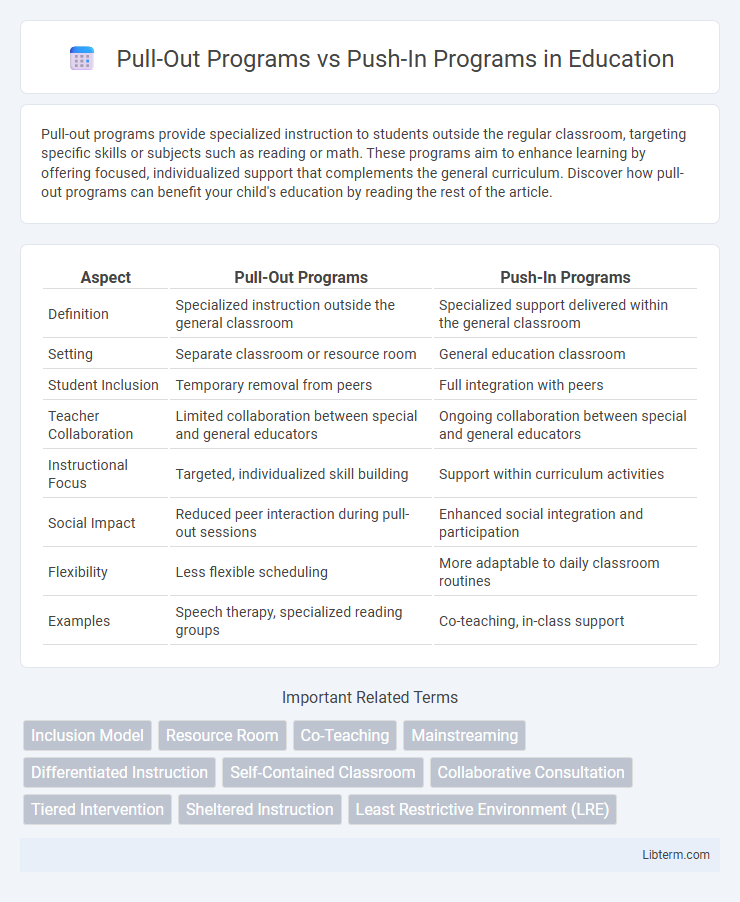Pull-out programs provide specialized instruction to students outside the regular classroom, targeting specific skills or subjects such as reading or math. These programs aim to enhance learning by offering focused, individualized support that complements the general curriculum. Discover how pull-out programs can benefit your child's education by reading the rest of the article.
Table of Comparison
| Aspect | Pull-Out Programs | Push-In Programs |
|---|---|---|
| Definition | Specialized instruction outside the general classroom | Specialized support delivered within the general classroom |
| Setting | Separate classroom or resource room | General education classroom |
| Student Inclusion | Temporary removal from peers | Full integration with peers |
| Teacher Collaboration | Limited collaboration between special and general educators | Ongoing collaboration between special and general educators |
| Instructional Focus | Targeted, individualized skill building | Support within curriculum activities |
| Social Impact | Reduced peer interaction during pull-out sessions | Enhanced social integration and participation |
| Flexibility | Less flexible scheduling | More adaptable to daily classroom routines |
| Examples | Speech therapy, specialized reading groups | Co-teaching, in-class support |
Introduction to Pull-Out and Push-In Programs
Pull-Out Programs involve removing students from their regular classrooms for specialized instruction tailored to their individual needs, often for subjects like gifted education or special education. Push-In Programs bring specialized educators into the general classroom to support students without interrupting their participation in the primary learning environment. Both models aim to enhance educational outcomes by providing targeted support, but differ in instructional delivery and integration within the classroom setting.
Defining Pull-Out Programs
Pull-out programs refer to specialized educational services where students are temporarily removed from the general classroom to receive targeted instruction in a separate setting, often focusing on specific skills such as reading or math. These programs aim to address individual learning needs through small group or one-on-one support, facilitating personalized attention that may not be feasible in a full classroom environment. Pull-out instruction is commonly used in special education and gifted education to enhance student achievement and accommodate diverse learning paces.
Understanding Push-In Programs
Push-In Programs integrate specialized support services directly into the general education classroom, promoting inclusivity and collaboration among students and teachers. These programs enhance learning by allowing students with diverse needs to access core curriculum alongside their peers, supported by co-teaching models and real-time assistance. Research shows that Push-In Programs improve academic outcomes and social interaction by creating a cohesive learning environment without removing students from their regular classroom setting.
Key Differences Between Pull-Out and Push-In Approaches
Pull-out programs remove students from the general education classroom for specialized instruction, ensuring targeted support for specific learning needs, while push-in programs deliver specialized services within the inclusive classroom environment to promote collaboration and immediate application of skills. Pull-out approaches often provide more individualized attention but may disrupt regular class participation, whereas push-in methods foster inclusion but can limit the intensity of individualized instruction. Key differences include location of service delivery, level of inclusion, and impact on social integration and instructional continuity.
Benefits of Pull-Out Programs
Pull-out programs provide targeted, individualized instruction that addresses specific student needs, enhancing academic achievement in subjects like reading and math. These programs allow educators to deliver specialized support in a distraction-free environment, which can improve student focus and confidence. Tailored interventions in pull-out settings foster skill mastery and promote long-term educational success for diverse learners.
Advantages of Push-In Programs
Push-in programs promote inclusivity by allowing special education teachers to deliver support directly within the general education classroom, fostering collaboration and minimizing stigma for students with diverse learning needs. They enhance real-time access to curriculum modifications and immediate intervention, which improves student engagement and comprehension. This integrated approach also benefits teachers by facilitating continuous professional development through shared strategies and joint problem-solving.
Challenges and Limitations: Pull-Out vs Push-In
Pull-Out Programs often face challenges such as interrupting the student's regular classroom routine and potentially causing social isolation from peers, which can hinder continuous learning and engagement. Conversely, Push-In Programs may struggle with limited instructional time and resources within the general education classroom, making it difficult for educators to provide individualized support effectively. Both models require careful coordination and training to overcome barriers related to inconsistent communication and fragmented instructional approaches.
Impact on Student Learning Outcomes
Pull-Out Programs provide targeted, individualized support by removing students from the general classroom, which can lead to improved mastery of specific skills but may cause disruptions in core class learning. Push-In Programs integrate support within the general classroom, promoting inclusivity and real-time assistance, often enhancing social interaction and engagement without sacrificing curriculum continuity. Research indicates that push-in models tend to foster higher overall academic achievement and better student confidence by maintaining consistent access to grade-level instruction while addressing diverse learning needs.
Selecting the Right Program for Diverse Learners
Selecting the right program for diverse learners involves evaluating Pull-Out Programs, which provide targeted support by removing students from general classrooms, and Push-In Programs, which deliver specialized instruction within inclusive settings. Pull-Out Programs benefit students needing focused, individualized help, while Push-In Programs promote collaboration and reduce stigma by integrating support services directly into the mainstream classroom. Factors such as student needs, staff expertise, and resource availability guide educators in choosing the most effective approach for maximizing academic and social outcomes.
Future Trends in Inclusive Education Programs
Future trends in inclusive education programs highlight a shift toward more integrated push-in models that support diverse learners within general education classrooms, leveraging technology and individualized instruction. Data-driven approaches emphasize personalized learning plans and collaboration among educators, specialists, and families to enhance student outcomes. Emerging practices also showcase a growing emphasis on social-emotional development and accessibility, ensuring equity and participation for all students.
Pull-Out Programs Infographic

 libterm.com
libterm.com